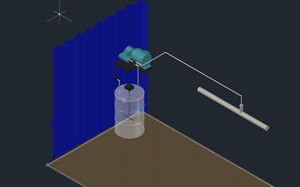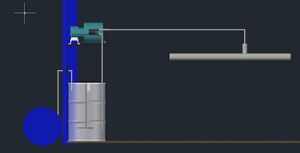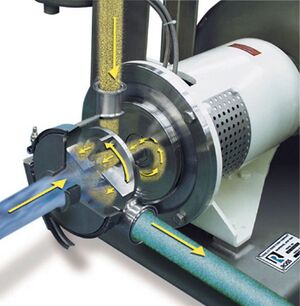NEW Wastewater Treatment
| N-E-W Tech(™) Biochar Filtration System | |
| Sponsors | |
| Team Name | NEWater |
| Duration | Fall 2015 - Spring 2016 |
| Faculty Advisers | |
| Mentors |
|
| Students |
|
Team NEWater has the goal of developing an autonomous mixing and injection system to help aid the current N-E-W Tech(TM) BioChar Filtration System.
Background[edit | edit source]
At the intersection of two of Idaho’s premier economic drivers, mining and agriculture, lies fertilizer. Phosphorus, nitrogen, and potassium are the main components in most fertilizers. Mining is the main source of these elements. As more and more of them are pulled from the ground and the resources become scarce, the price of fertilizer and its components will skyrocket. Unfortunately, it is unlikely that a new non-mining source of these materials will be discovered, so finding methods of reusing fertilizer becomes paramount. Most phosphorus, nitrogen, and potassium from fertilizer end up in our water system. Phosphorus can be removed using traditional precipitation methods, but these are only about 90% efficient and leave around 0.5 milligrams of phosphorus per liter of water. While this may sound like it works well enough, when one considers the amount of water used in our water systems, one realizes how much phosphorus (and these other elements) are still present in our waterways. N-E-W TechTM has developed a revolutionary new concept for filtering out phosphorus and other chemicals from wastewater. The fundamental problem with these materials is that they are too small to be easily filtered out. Using a compound known as biochar has proven effective to working around this constraint. Biochar is a carbon-based product formed by the pyrolysis of plant materials. As a porous material, it is often sold as a soil enhancer, as it promotes microbial growth and helps retain moisture. Biochar can be activated in a way that allows for phosphorus and nitrogen (and eventually other substances) to attach to it. Because biochar is much larger than these molecules (about 1 micron), it is easily filterable. This leaves an easy way to remove effectively all of the phosphorus and much of the nitrogen, and the by-product created is a soil enhancer laced with fertilizing chemicals which helps with plant growth and sequesters carbon.
Design Task[edit | edit source]
The first and most important requirement of the design was to dose biochar at a rate of 0.25-10 grams per liter of wastewater. This would ensure that the level of biochar could be adjusted at the correct rate according to the needs of the wastewater. Another need of the design was to be 100% scalable to industry standards. This meant that every component of the design had to have a scaled-up version capable of working in a system design for a large city that may require pumping hundreds or thousands of kilograms of biochar into millions of gallons of wastewater. Because the system as a whole is meant to be sold, it has to work for a large variety of situations. In addition, this wastewater eventually will be consumed by the public, so each item had to use food safe materials wherever it met water. This meant using plastics, stainless steel, and other materials made for this. A budget was never officially given for this project. Initially, orders under $100 had blanket permission to be made, with things over requiring permission. It was made widely known that there was plenty of money to be had and more could be acquired if needed. As the months went by and purchases were planned, more direction was given to avoid spending money, and ultimately it was decided that as little money as possible was to be spent.
Detailed Specifications[edit | edit source]
Design Goals and Deliverables[edit | edit source]
1. Inject biochar solution at rates from 0.25-10g/L of water in a manner that can be scaled upwards to meet industry standards.
2. Meter rates of injection within 10% of actual concentration.
3. Automated control of BioChar mixture and injection rates to suit varying water conditions.
4. System must be safe to operate and be mobile with existing container/vehicle combination.
Final Design Idea[edit | edit source]
The system begins with a food safe 55 gallon plastic drum. Biochar and water are mixed together in this drum to create a slurry. In order to pump a known concentration of biochar, the slurry must be kept in an even suspension. An agitator is used to accomplish this. Running a 4 inch impellor at 1725 rpm, more than enough upward velocity is achieved to keep even the highest concentration of slurries at an even suspension in less than three minutes. This agitator is mounted on a hand-crafted stand which positions the agitator directly over one of the cutouts in the drum’s lid. After a sufficient slurry is created, it is pumped out of a lower exit port that was cut into the side of the drum. A section of pipe and tubing channels the slurry to the pump. This section has a ball valve to shut off the flow from the drum, and has a coupling which allows the drum to be completely disconnected from the pump so that either of them are able to be moved. The pump used is a 1/2 hp 3-phase diaphragm pump. This ensures that the slurry never comes in contact with oil, chemicals, or surfaces that might compromise the safety of the consumer. This pump has the capability to pump from 1-5 gallons per hour with a 1:5 turndown ratio, which allows for tuning of the flow rate of the biochar to match the rate of wastewater and the concentration of the slurry. Use of a VFD allows for even more fine-tuning. The piping consists of 1/2 inch flexible hose to allow ease of access to different components of the system. This connects to the wastewater pipe by means of a check valve, which doesn’t allow the wastewater to flow into the biochar slurry.
Design Selection[edit | edit source]
The final design was settled on for a number of reasons. First was the budget, which ended up being more constrained than previously believed. An attempt was made to keep the total cost of the design below $3500, which meant that the Versi-feeder or a SLIM mixer were unable to be purchased. The SLIM mixer also would have broken the biochar down into smaller particles, which would destroy the ability it has to attach to nutrients in the wastewater and make it harder to filter. The budget constraints also made selection of a flow meter very difficult, as metering as low of a flow as this requires a flow meter which costs several thousand dollars. Constraints due to the abrasive nature of the biochar, which requires a robust metering system, were also an impediment to purchasing a flow meter. Another limiting factor that wasn’t considered early-on was the footprint and the amount of volume that each concept would take up. The trailer in which all of the components are mounted has a small amount of open room, and the 55 gallon drum and agitator take up a small amount of space. Integrating that idea also requires the least amount of changes to the existing system.
Previous Design Ideas[edit | edit source]
SLIM (Solid Liquid Injection Manifold)[edit | edit source]
When large amounts of powders need to be added quickly into liquid or hard-to-disperse solids take too long to completely incorporate, an inline high shear mixer with sub-surface powder injection capabilities is extremely worth considering. The problem that lies here is that most injection manifolds are made for industrial sized scaled. We are currently look at smaller scaled version to work with the mobile unit and how we can make a working laboratory version.
This system works perfectly for our needs because:
1. The water enters the mixer and immediately encounters the biochar through a vacuum created by the rotor.
2. Product is injected directly into a high shear zone suspending the biochar into the water.
3. Resulting mixture is expelled centrifugally through the stator openings in a high velocity to the system.
Agitator/Pump Combination[edit | edit source]
Another concept that was discussed was to use a 55 gallon drum as a vessel for mixing the biochar with water before pumping it to the wastewater system. This would require an agitator and impellor to be effective. Because of the relatively small size of the drum, baffling would not be necessary in order to create an even suspension of the biochar and water mixture. Pumping would need to be regulated by a flow meter in order to accurately dose the biochar into the wastewater. A system using a 55 gallon drum should be able to last an entire workday, severely cutting down on the man-hours required to keep it going. Pre-mixing the biochar with water is required to create adequate flow to the wastewater. In addition, biochar must always be kept wet in order to prevent its combustion. N-E-W TechTM had attempted previously to dose the biochar directly to the wastewater without achieving promising results. The 55 gallon drum could be acquired for less than $100 and could be made of steel or plastic. An adequate agitator was found for $848. It is 1/2 hp, runs on 110 V, and spins at 1750 rpm. With a four inch impellor, it would turn the drum at 217 gallons per minute and create an even suspension in 2.7 minutes. In total, this option would cost close to $1000 to do well, making it a very cost-effective option that would take up only a small amount of space.
VersiFeeder[edit | edit source]
A Versi Feeder is an type of volumetric feeder for feeding non-free-flowing materials. Biochar is flammable when dry, so it must be kept moist. The result is a high viscosity, which can make traditional pumping difficult. The Versi Feeder works by using controlled vibrations to move the non-free-flowing materials move down to an injection screw. After the biochar contacts the screw, a DC motor will push the biochar to the injection point using the screw. The feeder can be made in carbon or stainless steel, which meets the requirements for handling the biochar in a safe manner. Benefits of using the Versi Feeder include a high injection accuracy of ±1-2%, it is easy to clean and break down, can scale for bigger applications, can be made in safe materials, and the volumetric rate capacity is from 0.0037 to 0.037 cubic feet per hour, which perfectly meets the design requirements. Eventually it was decided that a direct-injection device such as this would not be used, however the Versi Feeder can be added in the future to the final design.
Combination Idea[edit | edit source]
We also looked at a combination of other ideas to create a new design. We would load biochar into a 55-gallon plastic drum using a corkscrew-shaped device. In the drum the biochar mixes with water and is held in suspension by an agitator. We use a pump to draw the biochar/water mixture out of the drum and push it into the wastewater pipe. We planned on using an ultrasonic or analog flow meter to measure the flow rate of the mixture as it goes into the wastewater. We also would have used a system of two check valves to regulate the flow of biochar into the wastewater and allow for a return pipe to help remove any residual biochar that may clog the injection site. The return pipe would be routed back to the 55-gallon drum.
Team Members[edit | edit source]
| Picture | Bio | Discipline |
|---|---|---|
Garrison Lewis:
I am a senior undergraduate majoring in Mechanical Engineering, minoring in Math at the University of Idaho and will graduate in May of 2016. Currently emphasizing my studies into thermodynamics and system applications. |
ME | |
Nicholas Richards:
I’m a senior studying Biological and Agricultural Engineering with a focus on Biomedical Engineering at the University of Idaho. I graduate in the Spring of 2016 I plan on working on prosthetics and medical devices for my career. |
BAE | |
Han Zhou:
I am a senior at the University of Idaho working toward my Bachelor of Science in Biological and Agricultural Engineering and will graduate in the Spring of 2016. |
BAE | |
Tao Jia:
I am a senior at the University of Idaho working toward my Bachelor of Science in Biological and Agricultural Engineering and will graduate in the Spring of 2016. |
BAE |
Future Work[edit | edit source]
Future work remains to be done on this project. One beneficial item which could be easily installed is a water level sensor. This could determine autonomously when the water and biochar mixture in the drum is low and should be refilled. If more infrastructure was put in place, the sensor could actually direct an automated machine to refill the biochar and water automatically. A corkscrew mechanism could fill load the biochar into the drum, and a simple piping system could handle the water. Another thing that would help the project would be to buy a flow meter to more accurately dose the biochar. A pressure sensor could also be used underneath the drum to determine the flow rate using weight. One last idea is to create a relief valve back into the drum, so that in the case of a failure, the biochar and water mixture could be safely rerouted away from the wastewater.










